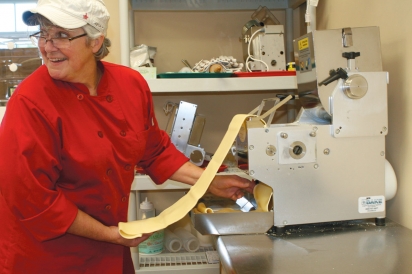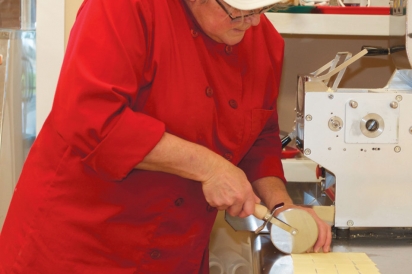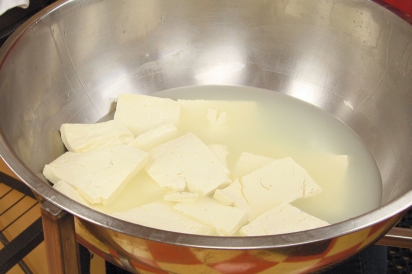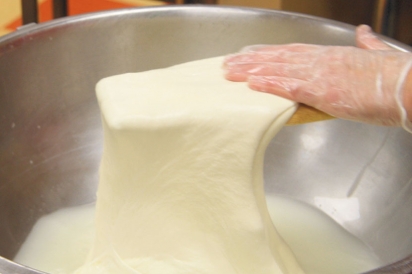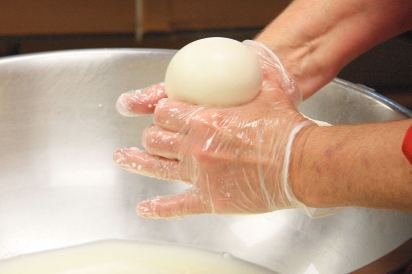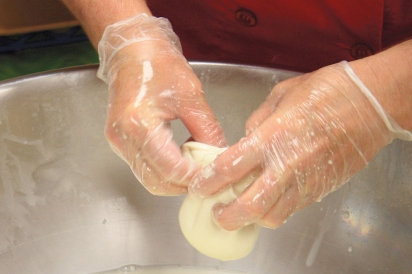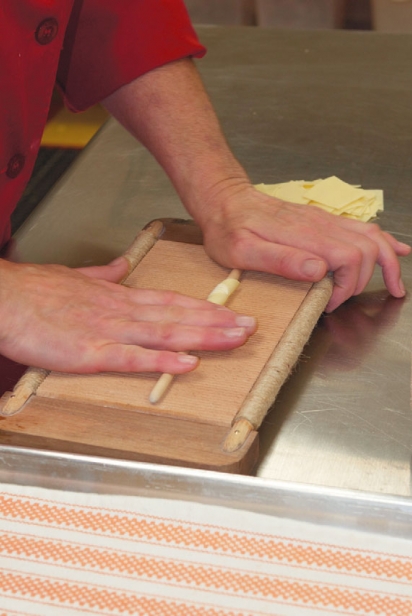Three Cheese for Pasta! Fromage à Trois Has Fans Shouting For More
One is arguably the most widely enjoyed food item on the planet, and the other’s very existence predates recorded history. From the bridges to Provincetown, there are more than enough opportunities to purchase a package of pasta or cheese to bring home. Freshly mixed, rolled and cut pasta, or a ball of mozzarella or burrata just out of the brine will prove to be a much more difficult find. Kathleen Kadlik and her partner Gail O’Connor have an established operation that provides these items and more, now at a new location. Fromage a Trois’ The West Village Pasta & Cheese Shoppe’s new home is located at 581 Main Street (Route 28) in West Dennis in Grand Cove Place (formerly the site of Christine’s Restaurant and Showclub).
As is often the case with those who are doing what they love, Kadlik’s journey to Fromage a Trois was a meandering one. Raised in Natick, Massachusetts, Kadlik was an art major in college. Like many with college degrees, such as philosophy or history of German literature (really, what do you do with that?), Kadlik entered into a completely different line of work. For 16 years she owned and operated Kathleen Klean, a cleaning company in the western suburbs of Boston. Upon retiring from the cleaning business, Kadlik enrolled in the Cambridge School of Culinary Arts. There she found that she leaned towards pasta, and around the same time, she attended a seminar on cheese making and discovered she very much enjoyed that as well. After relocating to the Cape, Kadlik needed a kitchen to get her venture off the ground. Enter Lisa Raffael, a Falmouth-based pastry chef, who offered Kadlik the use of her professional kitchen. “I never would have been able to start the business without Lisa and her help,” Kadlik recalls. So, armed with some recipes and standing in the middle of a friend’s kitchen, Fromage a Trois was born.
Kadlik began selling her pastas and cheeses at farmers’ markets in 2009, and the markets continue to be 50% of their business. Kadlik and O’Connor opened their first store along Route 149 in West Barnstable behind the General Store, located at the train crossing. The building itself has had a colorful history, so a tremendous amount of work was needed to make it feasible for the women to sell their products. After two years, the pair looked for other options to house their enterprise. They found the potential space in the new retail development in West Dennis. The lease was signed in January with the hope of opening in May. May became July when Fromage a Trois swung open their doors for business. While Kadlik crafts the cheese and pasta in the kitchen, O’Connor manages all the details on the business side. “She takes care of so much more than ‘the books’,” Kadlik says. “Gail handles not only the banking and payroll, but also the deliveries, marketing and runs the wholesale division.”
Many cultures have some version of pasta, such as orzo, pierogi, spaetzle or kreplach, to name a few. The inexpensive cost and boundless versatility make pasta a favorite the world over. The process of making pasta at The West Village Pasta & Cheese Shoppe is a relatively simple one. Kadlik uses only three ingredients: semolina flour, organic free-range eggs and salt. You won’t find the flour bleached or bromated, and there are no additives thrown in, either.
“It has to be semolina,” she states. “That’s what makes it pasta.” Semolina is the flour that is ground from durum wheat. Durum’s endosperm—tissue formed inside the seeds—is yellow in color, which gives pasta its familiar hue. The three ingredients are loaded into “Sophia” for mixing. When asked just who or what “Sophia” is, Kadlik responds, “It’s just a pasta machine.” She waits a beat, then follows with, “It sounds like such an insult to call her ‘just a pasta machine.’” The next logical question is: Why Sophia? With a nonplussed raise of the eyebrows, she replies, “Sophia Loren?” Oh, right. Kadlik further explains that it all goes back to the famous Sophia Loren quote: “Everything you see I owe to spaghetti.”
The shop features several types of pasta. There are the familiar forms, like fettuccine and tortellini, and lesser-known shapes like festoni, malloreddus and strozzapreti. One item that is an absolute must is ravioli; the filling is where Kadlik’s creativity truly shines. The mushroom ravioli feature a combination of both crimini and shiitake varieties with a blend of ricotta, shallot, cognac, garlic and thyme, while the five cheese ravioli stars Parmesan, ricotta, mozzarella, Romano and mascarpone with basil and garlic. A simple drizzle of a fine quality olive oil is all that’s needed to dress these wonderful little gems. If you’re inclined to sprinkle grated Parmesan over the top, Kadlik offers direction. “Always grate your own Parm,” she states. “Never buy the pre-grated stuff.”
Kadlik was able to exercise her artistic skills when she discovered online a 90-year-old wood carver in Liguria who would make a custom corzetti stamp for her. Corzetti were fashionable with Italian noble families who would stamp their heraldic badge on pasta discs. The pasta look like beautiful medallions, and the indentations and ridges made by the stamp hold sauce well. Kadlik designed a mermaid and a compass rose for her corzetti stamps. “The stamp is so sharp you can see the mermaid’s belly button in the pasta discs,” declares O’Connor.
Then again, why should Kadlik and her staff have all the fun making the pasta? They hold pasta-making classes for six (seven if you behave yourselves), and students in the beginner’s class get to knead, roll and cut their own pasta using artisan tools. In the “More Pasta Please” class, the focus is on filled pastas like ravioli. The advanced pasta pupils not only make their own pasta, but a number of fillings as well. What shapes they decide to create is left to their imagination.
Cheese was long thought to have been created by accident. Between five and ten thousand years ago, humans stored milk in containers made from animal stomachs. Inside these containers, the milk combined with enzymes (rennet) present in the stomachs, and as these containers were agitated during transport, the milk was separated into curds and whey, and voila: a basic cheese. By the time of the Roman Empire, hundreds of varieties of cheese were being produced and traded.
In more modern times, we were urged to “Behold, the power of cheese!”, and School House Rock, those 60-second nuggets of wisdom from back in the 1970s, taught more than one generation of kids the benefits of cheese. Today, you don’t need to wait until your ten-gallon hat is feeling five gallons flat to hanker for a hunk of Fromage a Trois’ cheese. Three kinds of cheese are available (hence the name), and all are based on mozzarella curd: mozzarella, burrata and Armenian string cheese.
Cheesemaking is where the labor kicks into another gear. It’s a straightforward process that is easy to foul up. Kadlik works with fivepound blocks of mozzarella curd from Narragansett Creamery in Providence, Rhode Island. “I like them,” she says. “They support a lot of small local dairies.” The curd is slowly softened in warm, and then hot, water. The speed at which the heat is added takes experience to get just right. Too fast and the cheese will become too runny to work with. Too slow, and the all-important butterfat that’s locked into the curd will escape by the time you’re done forming the cheese. This fivepound block is destined to become 18 burrata, a few mozzarella balls and some boccocini, those familiar little bite-size balls of mozzarella.
Kadlik works the slices of curd in the hot water bath to pull them together and combine them. It’s a technique not unlike kneading dough, and this process brings out the art major in her. “I loved ceramics. I loved throwing clay,” she recalls. “This is a lot like that. It’s all texture and feel.” All the while, her hands never stop, working and pulling the cheese until it’s to her liking. At that point, she lops off individual balls in the curve between the thumb and index finger of each hand. For the burrata, Kadlik flattens each ball and places a preportioned dollop of filling inside. Filling options include a traditional curds and cream; almond and fig; goat cheese; white truffle; and gorgonzola. A few pinches and a twist seals in the filling, and the cheese begins a gradual cool down in a series of progressively colder baths, then finishes in a salted brine. Armenian string cheese is simply mozzarella that has been twisted and folded over onto itself, over and over and over.
Another great offering from Fromage a Trois is the pasta club. Farmers have been doing CSAs for years; consider this a CSP (Community Supported Pasta) program. One-month memberships are available at three different price levels. The “Purist” receives freshly rolled pasta and a “take-and-bake” baguette each week. The “Foodie” gets the same items but the pasta is upgraded to fresh raviolis for two of the weeks. The top level, or “Entertainer”, earns two weeks of ravioli and burrata, one week where they receive enough rolled pasta for four, and a week of stuffed lumaconi (snail-shell shaped). All are paired with complimentary sauce each week. Kadlik makes five different sauces: classic red sauce, Arrabiata, mushroom cream, mushroom cream with white truffle, and Puttanesca. Dinner is done in one easy step!
Even non-club members can pick up everything they need for a delicious meal at The West Village Pasta and Cheese Shoppe. Along with the freshly made pastas and cheeses, Kadlik has a variety of sauces to choose from and other styles of dried pastas that are imported from Italy. Two types of olive oil are available. Partanna is a first cold-pressed oil that Kadlik uses for cooking. The Frantoia is an elegant extra virgin olive oil that should be used to finish pasta or salads. Only one balsamic vinegar will do, and that’s Rubio, a classic balsamic of Modena. Other elements to complete a perfect evening are also available for purchase, from an antipasto blend of olives to a little something sweet for dessert.
Farmers’ markets continue to play a major role in getting Fromage a Trois products into the hands of their faithful customers. If you go, get there early. “We sold out of everything at the Falmouth Farmers’ Market in an hour and a half,” Kadlik states. “We’re only limited by how much we can make.” It’s much the same story in Orleans. Kadlik continues, “People are lined up at the gate at 8 am. They make a beeline for us and Tim Friary’s booth.” Friary’s Cape Cod Organic Farm and Fromage a Trois are near each other and absolute fan favorites. Kathleen has two staff members working the markets in Osterville and Chatham as well. As the winter rolls in, Kathleen has eyes toward expanding to the Plymouth and Wayland Winter markets.
There is just something about the ability to purchase fresh food products, whether it’s bread or pastry just out of the oven, or fish that’s still on the bed of ice being loaded off the fisherman’s boat. Pasta that’s just been pressed and sliced through the chitarra or mozzarella balls that are still soft and warm…it’s a feeling of being on the inside, behind the velvet rope. You have access to something that most don’t. And now we have that opportunity with The West Village Pasta & Cheese Shoppe. Do yourself a favor and stop by to enjoy all that they have to offer before your get up ’n go has got up ‘n went!
The West Village Pasta & Cheese Shoppe
581 Main Street (Route 28), West Dennis
508-258-0212 / fromageatroiscapecod.com
Open Wednesday-Saturday, 10:00 am-5:30 pm Sunday, 10:00 am-3:00 pm
Larry Egan is an Associated Press award-winning writer and commentator and host of the talk show “The Handyman Hotline” on Saturdays from 1-3 pm on 95.1 WXTK-FM. Larry lives in Marstons Mills with his wife Cori and Ziggy, the Portuguese Water Wonder Dog.



